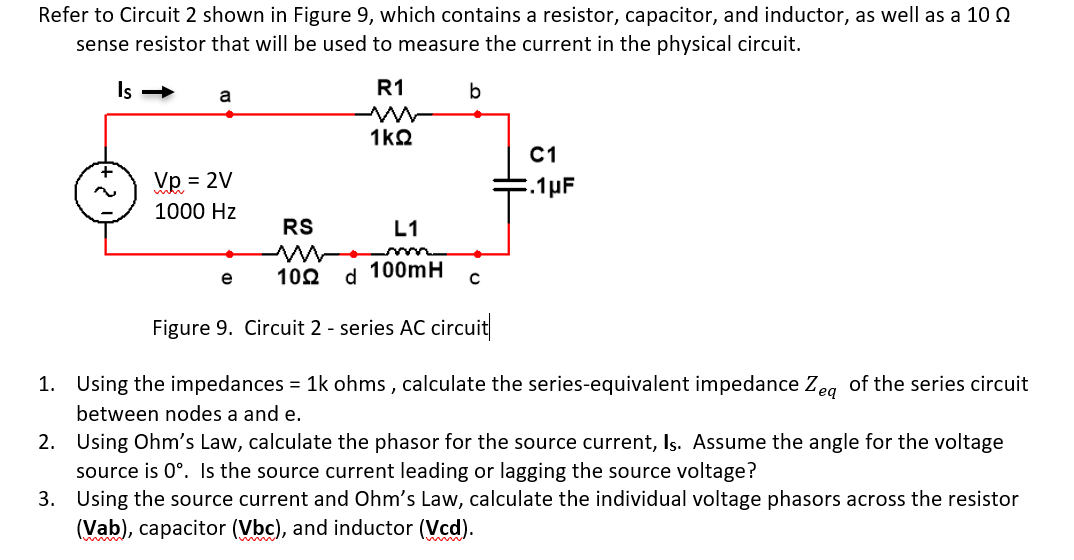Refer to Circuit 2 shown in Figure 9, which contains a resistor, capacitor, and inductor, as well as a 10 sense resistor that will be used to measure the current in the physical circuit. R1 Is -> a Vp= 1000 Hz = 2V RS 1kQ L1 100mH d b 1022 e Figure 9. Circuit 2 - series AC circuit с C1 .1μF 1. Using the impedances = 1k ohms, calculate the series-equivalent impedance Zea of the series circuit between nodes a and e. 2. Using Ohm's Law, calculate the phasor for the source current, Is. Assume the angle for the voltage source is 0°. Is the source current leading or lagging the source voltage? 3. Using the source current and Ohm's Law, calculate the individual voltage phasors across the resistor (Vab), capacitor (Vbc), and inductor (Vcd).
Refer to Circuit 2 shown in Figure 9, which contains a resistor, capacitor, and inductor, as well as a 10 sense resistor that will be used to measure the current in the physical circuit. R1 Is -> a Vp= 1000 Hz = 2V RS 1kQ L1 100mH d b 1022 e Figure 9. Circuit 2 - series AC circuit с C1 .1μF 1. Using the impedances = 1k ohms, calculate the series-equivalent impedance Zea of the series circuit between nodes a and e. 2. Using Ohm's Law, calculate the phasor for the source current, Is. Assume the angle for the voltage source is 0°. Is the source current leading or lagging the source voltage? 3. Using the source current and Ohm's Law, calculate the individual voltage phasors across the resistor (Vab), capacitor (Vbc), and inductor (Vcd).
Introductory Circuit Analysis (13th Edition)
13th Edition
ISBN:9780133923605
Author:Robert L. Boylestad
Publisher:Robert L. Boylestad
Chapter1: Introduction
Section: Chapter Questions
Problem 1P: Visit your local library (at school or home) and describe the extent to which it provides literature...
Related questions
Question
100%

Transcribed Image Text:Refer to Circuit 2 shown in Figure 9, which contains a resistor, capacitor, and inductor, as well as a 10
sense resistor that will be used to measure the current in the physical circuit.
Is →
a
Vp = 2V
1000 Hz
RS
R1
ww
1kQ
b
L1
102
e
100mH
d
Figure 9. Circuit 2 - series AC circuit
C
C1
E.1 μF
1.
Using the impedances = 1k ohms, calculate the series-equivalent impedance Zea of the series circuit
between nodes a and e.
2.
Using Ohm's Law, calculate the phasor for the source current, Is. Assume the angle for the voltage
source is 0°. Is the source current leading or lagging the source voltage?
3.
Using the source current and Ohm's Law, calculate the individual voltage phasors across the resistor
(Vab), capacitor (Vbc), and inductor (Vcd).
Expert Solution
This question has been solved!
Explore an expertly crafted, step-by-step solution for a thorough understanding of key concepts.
Step by step
Solved in 2 steps with 1 images

Knowledge Booster
Learn more about
Need a deep-dive on the concept behind this application? Look no further. Learn more about this topic, electrical-engineering and related others by exploring similar questions and additional content below.Recommended textbooks for you

Introductory Circuit Analysis (13th Edition)
Electrical Engineering
ISBN:
9780133923605
Author:
Robert L. Boylestad
Publisher:
PEARSON

Delmar's Standard Textbook Of Electricity
Electrical Engineering
ISBN:
9781337900348
Author:
Stephen L. Herman
Publisher:
Cengage Learning

Programmable Logic Controllers
Electrical Engineering
ISBN:
9780073373843
Author:
Frank D. Petruzella
Publisher:
McGraw-Hill Education

Introductory Circuit Analysis (13th Edition)
Electrical Engineering
ISBN:
9780133923605
Author:
Robert L. Boylestad
Publisher:
PEARSON

Delmar's Standard Textbook Of Electricity
Electrical Engineering
ISBN:
9781337900348
Author:
Stephen L. Herman
Publisher:
Cengage Learning

Programmable Logic Controllers
Electrical Engineering
ISBN:
9780073373843
Author:
Frank D. Petruzella
Publisher:
McGraw-Hill Education

Fundamentals of Electric Circuits
Electrical Engineering
ISBN:
9780078028229
Author:
Charles K Alexander, Matthew Sadiku
Publisher:
McGraw-Hill Education

Electric Circuits. (11th Edition)
Electrical Engineering
ISBN:
9780134746968
Author:
James W. Nilsson, Susan Riedel
Publisher:
PEARSON

Engineering Electromagnetics
Electrical Engineering
ISBN:
9780078028151
Author:
Hayt, William H. (william Hart), Jr, BUCK, John A.
Publisher:
Mcgraw-hill Education,